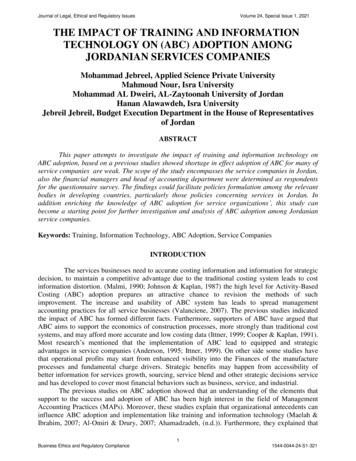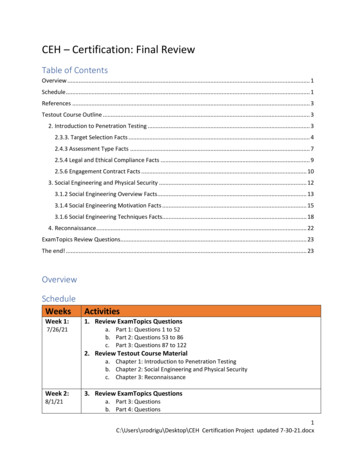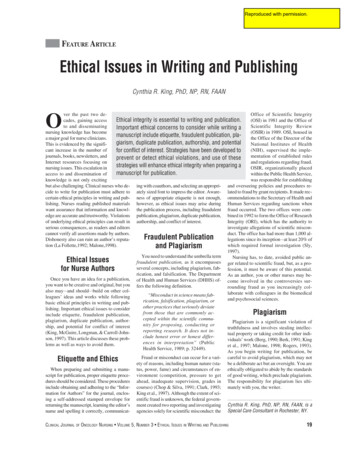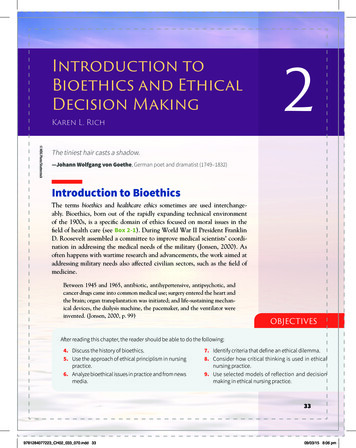
Transcription
Journal of Legal, Ethical and Regulatory IssuesVolume 24, Special Issue 1, 2021THE IMPACT OF TRAINING AND INFORMATIONTECHNOLOGY ON (ABC) ADOPTION AMONGJORDANIAN SERVICES COMPANIESMohammad Jebreel, Applied Science Private UniversityMahmoud Nour, Isra UniversityMohammad AL Dweiri, AL-Zaytoonah University of JordanHanan Alawawdeh, Isra UniversityJebreil Jebreil, Budget Execution Department in the House of Representativesof JordanABSTRACTThis paper attempts to investigate the impact of training and information technology onABC adoption, based on a previous studies showed shortage in effect adoption of ABC for many ofservice companies are weak. The scope of the study encompasses the service companies in Jordan,also the financial managers and head of accounting department were determined as respondentsfor the questionnaire survey. The findings could facilitate policies formulation among the relevantbodies in developing countries, particularly those policies concerning services in Jordan. Inaddition enriching the knowledge of ABC adoption for service organizations’, this study canbecome a starting point for further investigation and analysis of ABC adoption among Jordanianservice companies.Keywords: Training, Information Technology, ABC Adoption, Service CompaniesINTRODUCTIONThe services businesses need to accurate costing information and information for strategicdecision, to maintain a competitive advantage due to the traditional costing system leads to costinformation distortion. (Malmi, 1990; Johnson & Kaplan, 1987) the high level for Activity-BasedCosting (ABC) adoption prepares an attractive chance to revision the methods of suchimprovement. The increase and usability of ABC system has leads to spread managementaccounting practices for all service businesses (Valanciene, 2007). The previous studies indicatedthe impact of ABC has formed different facts. Furthermore, supporters of ABC have argued thatABC aims to support the economics of construction processes, more strongly than traditional costsystems, and may afford more accurate and low costing data (Ittner, 1999; Cooper & Kaplan, 1991).Most research’s mentioned that the implementation of ABC lead to equipped and strategicadvantages in service companies (Anderson, 1995; Ittner, 1999). On other side some studies havethat operational profits may start from enhanced visibility into the Finances of the manufactureprocesses and fundamental charge drivers. Strategic benefits may happen from accessibility ofbetter information for services growth, sourcing, service blend and other strategic decisions serviceand has developed to cover most financial behaviors such as business, service, and industrial.The previous studies on ABC adoption showed that an understanding of the elements thatsupport to the success and adoption of ABC has been high interest in the field of ManagementAccounting Practices (MAPs). Moreover, these studies explain that organizational antecedents caninfluence ABC adoption and implementation like training and information technology (Maelah &Ibrahim, 2007; Al-Omiri & Drury, 2007; Ahamadzadeh, (n.d.)). Furthermore, they explained that1Business Ethics and Regulatory Compliance1544-0044-24-S1-321
Journal of Legal, Ethical and Regulatory IssuesVolume 24, Special Issue 1, 2021the effect of ABC adoption on organizational performance for services companies due to the ABCcan play main role in providing accurate information for managerial operating decisions and reflectthat on profitability in services organizations.Further studies on the ABC adoption s focused in developed countries, (e.g., Askarany &Yazdifar, 2009; Pavlatos & Paggios, 2009; Rahmouni & Charaf, 2010; Rajasekaran et al., 2011;Saxena et al., 2011; Arora, 2013; Horngren et al., 2013; Shaban, 2014). Limit studies was focusingin developing countries such as Jordan (Maelah, 2010; Fei & Isa, 2010; Rbaba'h, 2012; Al-Refa’ee,2012; Nassar et al., 2013; Mansour, 2015), as will existing studies also, give more attention forservices organization (Al-Omiri & Drury, 2007; Yazdifar & Tsameny, 2012) and few studiesinvestigated the relationships in the Jordanian services organizations (Rbaba'h, 2012; Hutibat, 2012;Nassar et al., 2013; Mansour, 2015).Nassar, et al., (2009; Al-Refa’ee (2012); Rbaba'h (2012); Nassar (2013) mentioned thatthe most cited factors affect to adopt ABC are adequate from training level and the role ofinformation teqnology (Al-Refa’ee, 2012; Rbaba'h, 2012; Nassar, 2013). The level of awarenessabout the ABC system among financial managers in high positions is an important factor in itssuccessful adoption in Jordanian services companies it can be improve their performance becausethe competition levels in Jordan will be influenced greatly by the adoption of the ABC system; thistype of system greatly enhance the profitability, y (Al-kahdash & Nassar, 2010; Al-Refa’ee, 2012;Rbaba'h, 2012). Within the Jordanian case, Jordan is a developing country. It is very attractive forforeign investments, due too many reasons such as safety, political stability and its central locationin the Middle East. In same time the service sector in Jordan is significantly support to promotingthe Jordanian dinar exchange rate in light of their stability by supporting the Jordanian foreigncurrency reserves (Jaradat et al., 2018). As explained in Jaradat et al., (2018), the sector ofmanufacturing greatly affects the achievement of financial stability through support the treasuryevery year from the direct and indirect taxes.THEORETICAL REVIEWTrainingTraining is defined as the effort made by gaining a person’s knowledge and experienceabout system or to transfer their organizational skills regarding specific service (Omotayo, 2015).Therefore, this research, it is important to ascertain enhance the training level for all the staffs aretrained so as to enhance their knowledge about an ABC system before its adoption, and how thisfactor effects on organizational performance in service organizations. Additionally, the employeesin service organizations through the training help share responsibility and are aware of their role onthe organization and enables them to identify what they are and aren’t engaging with. Thus, thisleads to ensure that your employees get better training in any system.Information TechnologyInformation technology is very important in operational process provides the ability topresent timely and accurate information, resulting in supported managerial and employee decisionmaking processes. In the service organizations, information technology can be practised in bothaccounting-related and non-accounting processes (Al-Nuaimi et al., 2017; James, 2013; Daoud etal., 2015; Darko et al., 2016). Information technology is consider main role communicationsnetworks for a company, safeguarding data and information and helping employees doing a rangeof other action to ensure the efficiency and security of information are required for management inservice organizations (Al-Nuaimi et al., 2017).2Business Ethics and Regulatory Compliance1544-0044-24-S1-321
Journal of Legal, Ethical and Regulatory IssuesVolume 24, Special Issue 1, 2021ABC AdoptionAdoption is a term as the acceptance and the use of something new idea. Adoption refers tomake a decision to complete use of an innovation as the available top course of action (Burgess,2012). In the context of the service organizations, Tatnall & Burgess (2012) explained that adoptionto the admission of a novel innovation for the purpose of adoption. In this research, adoption refersto the ability of the service organizations to acceptance of the ABC as an innovation. Thisinnovation has been created interest in researchers’ and practitioners’ for the implementation ofABC in service organizations as a result of ABC’s excellence over traditional costing methods andits significance in enhancing organizational performance (Fei & Isa, 2010; Fatma & Habib, 2014;Jibril, 2018).Hypothesis DevelopmentThe idea of activity based costing system adoption are based conceptual framework. Figure(1) explains the framework of research. In this conceptual framework, the main factor ABCadoption by (training, information Technology and ABC adoption independent and dependentvariables respectively. This research attempts to bridge the gap by providing a basis for discerningthe effect the ABC factor successes.Training and ABC adoptionTraining is required as considered the effort put forth by any service organization totransfer knowledge and experience about organizational skills regarding specific services (Botelho,2012). It is very necessary for the staff to be trained as to enhance their knowledge about ABCsystems before its adoption. The studies showed that there is a significant employee’s improvementin the skills of after going through a training regime (Maelah et al., 2006; Botelho, 2012).Therefore, the ABC’s attempt to is to not only educate staff about the system; it is also to counterany resistance any new system application may cause.The training is helps the receiver (employee) acquire a certain minimum amount ofknowledge on how the system works, attaining a desired level of skill (Prabowo & Simpson, 2011;Darko et al., 2016; Daoud et al., 2015). The contingency theory considers adequate training as amain factor necessity to effect the adoption of the ABC. Thus, this research is going to test thefollowing hypothesis:H1: The training is positively related to ABC adoption.Information Technology and ABC adoptionJusoh & Miryazdi (2015) explained that the role of Information Technology (IT) ismore significant to influence ABC diffusion, also Cagwin & Bouwman (2002) explained that ABCrequires higher levels of IT for providing detailed data compared with the traditional costing systemdue to its need high IT quality and resolves the difficulty in identifying an accurate cost driverwithin the ABC adoption stages. In same time, Jibril (2018) mentioned that the quality of IT islikely to influence ABC adoption among service companies. Fie and Isa (2010) further investigatedthat the relationships between IT and ABC adoption. He found that the quality of IT is positivelyrelated to ABC adoption.(Ruhanita, 2006; Jibril, 2018) explained that the Information technology has important roleABC to performance measure and influenced the ABC adoption significantly. Additionally, Fie &3Business Ethics and Regulatory Compliance1544-0044-24-S1-321
Journal of Legal, Ethical and Regulatory IssuesVolume 24, Special Issue 1, 2021Isa (2010) found that the impact of Information technology can be give effective role on ABCadoption and implementation. From the aforementioned discussion, therefore, the followinghypothesis is proposed by this study:H2: The Information technology is positively related to ABC adoption.RESEARCH MODELIn general, the contingency theory is an organizational theory that based that the best wayto lead the company, or to make decisions, the optimal action is contingent upon the internal andexternal situation of the company (Jibril, 2018). The contingency perspective has been employed inmanagement accounting studies to indicate a range of contingent variables including organizationstructure (Chia, 1995; Gosselin et al., 2005), training (Chenhall & Langfield-Smith, 1998b), andaccounting information system design (Otley, 1980).Contingency theory explains the factors that impact on the ABC adoption (Cadez &Guilding, 2008; Jibril, 2018; Kallunki & Silvola, 2008; Liu & Skillet, 2007). Based on this theory,there has been change on the present management accounting innovation in order to responding theconditions faced by firms; thus, these the change to practice were affected by the contextual andorganizational factors and these are turned as contingency factors (Jebril, 2018).According to the contingency theory perspective, this research will highlight the role oftraining and information technology the internal organizational such as contextual andorganizational factors and external environmental variables. These factors will directly effect on theABC adoption. The significant determinant of ABC adoption is the contingent fit between theorganizational internal and the contingencies. Also, the contingency theory reported the factorsinfluencing its adoption. Hence, these factors have effect on the accounting and informationsystems. This enables the managers and companies to adapt quickly to changing markets andtechnologies for the adopting accounting and organizational changes.FIGURE 1ABC FACTORS IN ABC ADOPTIONRESEARCH METHODOLOGYZikmund, et al., (2013) mentioned that objectives, availability of information, and costfor conducting research, this research adopts a survey method since the data obtained from a survey4Business Ethics and Regulatory Compliance1544-0044-24-S1-321
Journal of Legal, Ethical and Regulatory IssuesVolume 24, Special Issue 1, 2021is used to examine the relationships between the dependent and independent variables (Bryman &Bell, 2015). In addition, as the respondent is financial managers, has expected to be highlyeducated, making a survey approach the most suitable technique for this context (Cooper et al.,2006). Jarrdat (2018) reported that the advantage of the survey strategy is that a large amount ofdata can be gathered from respondents, and the results can be generalized to the population at large.Oppenheim (2000) explained that an instrument should fulfil two requirements: Relevancyand accuracy. In terms of fulfilling the relevancy requirement, this research employedquestionnaires to gather information on the research objectives. Concerning the fulfilment of theaccuracy requirement, (Zikmund et al., 2013).The effect of training and information technology on the ABC adoption was examined inthis research via the application of questionnaires distributed to financial managers of 291 randomlyselected Jordanian service organizations. The questionnaire consists of three main sections: Part Ato Part C Part A gathers demographic data of the respondent and his/ her companies. Part B focusedon the factors (training and information technology) influencing the ABC adoption; Part C gathersdata related information about ABC adoption in companies.Five items representing the construct of training and ABC adoption were supplementedwith a 5-point Likert scale S1-S5 range as well where S1 “strongly disagree” while S5 signifies“strongly agree.” five items representing the construct of information technology weresupplemented with a 5-point Likert scale with S1-S5 range as well where S1 “strongly disagree”while S5 signifies “strongly agree.” Meanwhile, a total of six items were representing the constructof ABC adoption.RESULTS AND DISCUSSIONData AnalysisFactor analysis was in this research, and evaluation was made to the measures of theconstruct to determine both its reliability and validity. Further, the model proposed in this studydemonstrates the used variables’ unidimensionality, in the explaining of factor analysis. With theuse of AMOS-SEM, the (measurement model) and the (structural model) were evaluated after thedata have been checked and screened. In particular, AMOS-SEM analysed this study’s directresults.Measurement ModelBased on the Amos-SEM. The component measurement was included in the model and thismodel provides the determination the indicators (items) hypothetically and link to the resultantconstructs. In this study, the model analysis results affirm that the items of the survey measure theconstructs as they should, affirming both their validity and reliability.ConstructTRATable 1CONVERGENT VALIDITY 0.9480.7860.8540.6625Business Ethics and Regulatory Compliance1544-0044-24-S1-321
Journal of Legal, Ethical and Regulatory IssuesABCAVolume 24, Special Issue 1, 7For each construct used in this study, its values of CR and Cronbach’s alpha were determined(see Table 1). The constructs used in this study all achieved the values of CR and Cronbach’s alphathat are greater than the suggested threshold value of 0.70 (see Hair et al., 2013; Henseler et al.,2009; Wong, 2013). Furthermore, Henseler, et al., (2009) elaborated that convergent validity relatesto the degree to which measures of constructs with theoretical association are linked.Hypotheses TestingIn this research, the test was executed on the hypothesised model with the first stage inapplication of Amos-SEM algorithm. Accordingly, as explained in Table 2:HypothesesTRA ABCAIT ABCATable 2Results of Hypothesized Direct Effects of the VariablesPath coefficientT. StatisticsP-ValuesDecision0.2003.2750.075H1 Supported0.2684.0360.000H2 SupportedConcerning with the path between TRA, IT constructs and ABCA construct (Hypotheses (H1and H2), the beta coefficient is positive and statistically significant at p-value 0.001 (β 0.200;t 3.275 and β 0.268; t 4,036, respectively).Discussion of ResultsThis research found that the relationship between TRA and IT with ABC adoption ispositive; this result supported by hypothesis H1 and H2. Based on that, it seems that TRA and ITmake effective role on ABC adoption. This result in line with studies that support a positiverelationship between TRA and ABC adoption (Jibril, 2018; Nassar et al., 2011; Al-Refa’ee, 2012;Fadzi & Rababah, 2012; Rababah, 2014). Also, this result in line with studies that support a positiverelationship between IT and ABC adoption (Nassar et al., 2011; Al-Refaee, 2012; Rababah, 2012,Jibril, 2018).Based above discussion in the previous sections, the Following framework is, explained byFigure 1, for this research. This research aim to investigate the roles of the ABC factors on ABCadoption among Jordanian service companies. The research seek to as a wake-up call for reformingthe management innovations in Jordan.6Business Ethics and Regulatory Compliance1544-0044-24-S1-321
Journal of Legal, Ethical and Regulatory IssuesVolume 24, Special Issue 1, 2021CONCLUSIONS AND RECOMMENDATIONThe calls for additional research using a contingency perspective to understanding of ABCadoption in service companies and the increasing importance of service companies globally,especially in developing countries has motivated this research. Therefore, among servicecompanies, this research explores training and information technology in terms of the factorsinfluencing on ABC adoption.Considering the positive effect training and information technology on ABC adoption, themanagers and decision-makers should increase the knowledge of ABC adoption. Likewise,professional bodies should enrich the knowledge of ABC adoption particularly concerning inservice companies through the use of workshops and conferences. As the effect training andinformation technology on enhance the level of ABC adoption, policymakers should encouragethese role on ABC adoption in service companies. Therefore, considering the positive impact ofthese factors on ABC adoption, managers and decision-makers in service companies should takethese factors into consideration when making their decisions.This research provides knowledge on ABC adoption in service companies in developingcountries. According to study results, the concerned bodies could be assisted in reformulating thepolicies associated with service companies. Also, the awareness of factors affecting ABC adoptionassists the professional bodies in the enrichment of service companies understanding particularlyconcerning the ABC adoption affecting factors. In the context of service companies, this researchcan stimulate more scrutiny and analysis concerning service companies.However, there are several limitations related to this study which are worth considering.Firstly, the variables employed in this research were limited and this may cause the neglect ofcertain vital variables. Hence, there is merit in having the understanding of other factors related toABC adoption on service companies. Accordingly, among these factors are: organizational culture,as well. Another notable limitation is the use of limited sample in this research, whereby itconsisted the service companies. The use of limited sample reduces the generalizability of theoutcomes of this research to other types of organisations in other service. Hence, it might be ofvalue to consider other sectors, for instance, service and manufacturing companies as this wouldallow comparison of outcomes, increasing the generalisation.REFERENCESAl-Khadash, H., & Feridun, M. (2006). Impact of strategic initiatives in management accounting on corporate financialperformance: Evidence from Amman Stock Exchange. Managing Global Transitions, 4(4), 299–313.Abu-Tapanjeh, A.M. (2008). Activity-based costing approach to handle the uncertainty costing of higher educationalinstitutions: Perspective from an academic college. JKAU: Econ. & Adm. 22, 29-57.Anderson, S.W. (1995b). A framework for assessing cost management system changes: The case of activity basedcosting implementation at General Motors, 1986-1993. Journal of Management Accounting Research, 7, 1-51.Anderson, S., & Young, S. (2001). The impact of contextual and process factors on the evaluation of activity-basedcosting systems. Accounting, Organizations and Society, 24, 525-559.Anthony, R.N. (1989). Reminiscences about management accounting. Journal of Management Accounting Research, 1,1-20.Armitage, H.M., & Nicholson, R. (1993). Activity-based costing: A survey of Canadian Practice, 3. Society ofManagement Accountants of Canada.Babad, Y.M., & Balachandran, B.V. (1993). Cost driver optimization in activity-based costing. The Accounting Review,68(3), 563-575.Chongruksut, W. (2002). The adoption of activity-based costing in Thailand. Unpublished PhD, Victoria University.Cooper, R.B., & Zmud, R.W. (1990). Information technology implementation research: A technological diffusionapproach. Management Science, 36(2), 123–139.Cooper, R., & Kaplan, R.S. (1991). Profit priorities from activity-based costing. Harvard Business Review, 130-137.Cooper, R., & Kaplan, R.S. (1992). Activity-based systems: Measuring the costs of resource usage. Accounting7Business Ethics and Regulatory Compliance1544-0044-24-S1-321
Journal of Legal, Ethical and Regulatory IssuesVolume 24, Special Issue 1, 2021Horizons, 6(3), 1.Green, F.B., & Amenkhienan, F.E. (1992) Accounting innovations: A cross-sectional survey of manufacturing firms.Journal of Cost Management for the Manufacturing Industry, (spring), 58-64.Gosselin, M. (1997). The effect of strategy and organizational structure on the adoption and implementation of activitybased costing. Accounting, Organizations and Society, 22(2), 105-122.Hoffman, R.C. (1999). Organizational innovation: Management influence across cultures. Multinational. Bus. Rev.,7(1), 37.Innes, J., & Mitchell, F. (1991). ABC: A survey of CIMA members. Management Accounting (UK), October, 28-30.Fie, Z., & Isa, C. (2010). Factors influencing activity-based costing success: A research framework. InternationalJournal of Trade, Economics and Finance, 1(2).Johnson, H.T., & Kaplan, R.S. (1987). Relevance lost: The rise and fall of management accounting. Boston, MA:Harvard Business School Press.Jusoh, R., & Miryazdi, S.M. (2015). The influence of technological and environmental factors on the diffusion ofactivity-based costing in Iran. Tékhne, 13(2), 95-109.Lana, YJL., Fei, P. (2007). The implementation of activity-based costing in China: An innovation action researchapproach. Brit. Acc. Rev, 39(3), 249-264.McGowan, A.S., & Klammer, T.P. (1997). Satisfaction with activity-based cost management implementation. J.Manage. Acc. Res., 9, 217-237.Ministry of Planning Report. (2007). The Economic indicators, Amman, Jordan, 2007.MacArthur, J.B. (1996). From activity-based costing to throughput accounting. Management accounting (April),30(34), 36-38.Mohammed, A.O., Colin, D. (2007). Organizational and behavioral factors influencing the adoption and success ofABC in the UK. Cost. Manage. 21(6), 38-48.Norris, G. (1997). The formation of managers' views of ABC and their impact on the outcome of its use: A GroundedTheory Case Study' Acc. Res. J., 10(2), 180-200.Ruhanita, M., & Daing-Nasir, I. (2006). Activity Based Costing (ABC) adoption among manufacturing organizations The case of Malaysia. Inter. J. Bus. Soc., 7(1), 70-101.Shields, M., & Young, S. (1989). A behavioral model for implementing cost management systems. Journal of CostManagement, winter, 17-27.Shield. (1995). An empirical analysis of firms' implementation experiences with activity-based costing. ManagementAccounting Research, 7, 148-166.Taba, L.M. (2005). Measuring the successful implementation of Activity Based Costing (ABC) in the South African postoffice unpublished master thesis. University of South Africa.Valanciene, L., & Gimzauskiene, E. (2007). Changing role of management accounting: Lithuanian experience casestudies. Inzinerine Economical Engineering Economics, 5, 16-2.8Business Ethics and Regulatory Compliance1544-0044-24-S1-321
The idea of activity based costing system adoption are based conceptual framework. Figure (1) explains the framework of research. In this conceptual framework, the main factor ABC adoption by (training, information Technology and ABC adoption independent and dependent variables respectively.











